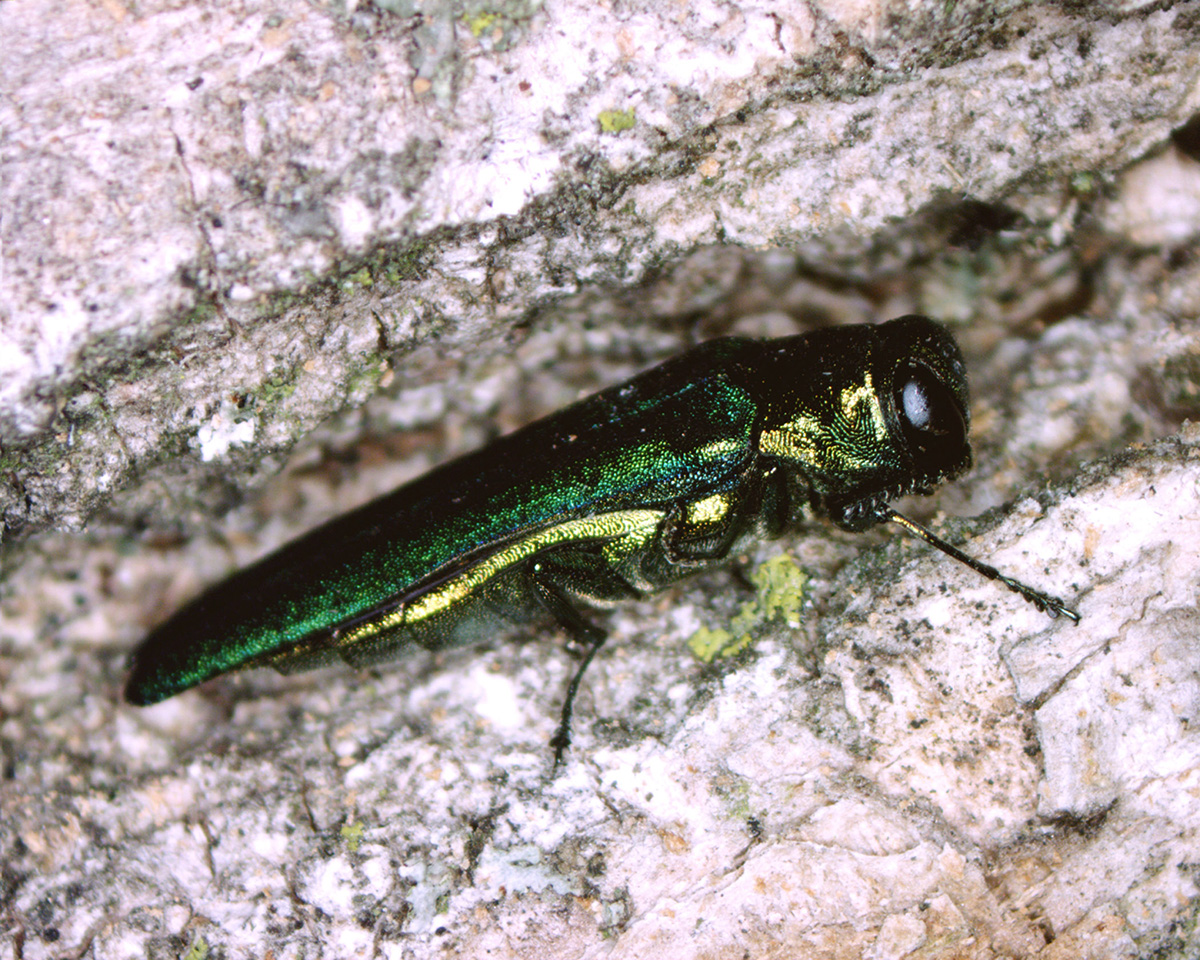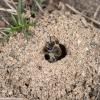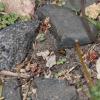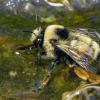In our last blog, we talked about the important role that ash trees play in our native ecosystems. We also learned about new research and approaches for slowing the spread of a damaging invasive species, the emerald ash borer (EAB).
Now, we’ll discuss ways we can slow the spread and minimize the harm of EAB, from before they arrive, to handling a new infestation, to deciding the best course of action for your at-risk trees. The very first step, of course, is learning to spot emerald ash borer infestations early to give your local trees and wildlife their best shot at resiliency.
Learn to Spot EAB Infestations Early
Monitor your ash trees and their health
Locate ash trees on your property and begin checking them regularly. If you are not sure how to identify ash trees, ask if your town has completed a tree inventory and learn how to identify Fraxinus. Few external signs of EAB infestation are visible until trees have been infested for at least 2-4 years. As larval densities build, you may see cracks in the bark over larval galleries, thin canopies or branch dieback. Trees will produce shoots on the trunk or large branches as they decline.
Learn how to identify EAB and their signs
Adult EAB beetles are small and rarely observed, as they spend most of their time in the upper canopy of ash trees. Woodpeckers are much better at finding EAB larvae than we are. Watch for woodpecker holes on the main trunk or on large branches high in the canopy. Adults are active May through mid-late summer. If you suspect EAB is present, try to capture a beetle or take a photo. Get a positive diagnosis since the metallic green, half-inch adult EAB may be confused with other native insects. Other signs of EAB include tiny D-shaped exit holes in the bark. Baited specialized traps that attract adult EAB may be somewhat helpful for detecting EAB before tree symptoms become evident.
Report findings to local government
If you find symptoms or signs of EAB, report your findings to your local government
In Oregon, report to the Oregon Invasive Species Online Hotline.

Reduce the Risk of EAB Infestation in Your Area
Keep your trees healthy
EAB prefer stressed ash trees in newly infested areas. Soil compaction, flooding, drought, or other problems can increase EAB attraction to ash trees. Where feasible, prevent or reduce these stresses on your ash trees to give them their best shot at survival.
Don’t move ash
Avoid purchasing or moving ash nursery stock, logs, firewood, or other ash wood products, which may carry larvae or pupae under the bark.
Plant trees other than ash
Until a longer-term solution is available, it is prudent to plant other native trees in cities and towns.
Advocate for a Collaborative Approach to Reduce Damage
Once EAB are within 30 miles, you have difficult decisions to make. While we are not sure yet exactly how newly exposed species such as Oregon ash will be affected, we know from experience elsewhere that most species of ash are vulnerable and die.
Before doing anything, find out if your city/town or county is participating in an area-wide strategy such the SLow Ash Mortality approach (SLAM) described in our previous blog about EAB. If so, consider cooperating with that strategy.
If your community is not participating in an area-wide strategy, you can advocate for the SLAM approach so that your community can gain the benefit of coordination and strategy. By coordinating a “trap and treat” program, your community may reduce the amount of insecticide used locally, reduce the costs of hiring professionals to treat trees, and better protect ash and the species that depend on them.
If All Else Fails, Consider Options for Trees on Your Property
If you are unable to help your community undertake an area-wide approach, you’ll need to make decisions for your property individually. Options to consider include:
- Removing ash trees. This is usually safer to do before the trees die.
- Committing to ongoing treatments with a systemic insecticide. Products with emamectin benzoate are applied via trunk injection and can provide 3 years of protection for ash trees. However, studies suggest that toxic impacts to exposed caterpillars (the larvae of butterflies and moths) may be severe. Azadiractin (neem oil) and other systemic insecticides must be re-applied annually, but preliminary studies suggest less severe impacts to caterpillars from azadiractin than from emamectin benzoate treatments.
- Allowing the tree to stay without treatment or removal, to determine if it may possess resistant genes. Resistant trees are rare, so do not be surprised if the tree dies. If it survives, you will have made an invaluable discovery.
Tree Removal
Tree removal may make sense if the tree is unhealthy, damaged, stressed or not growing in a good place; not particularly valued in your landscape; potentially hazardous to structures or people; or small (less than 8 inches diameter). Live trees selected for removal could be put to use as girdled trap trees first, provided they are debarked, burned or chipped promptly after felling. Consult your local government to understand how to properly handle any felled trees intended for lumber, firewood, or other uses.
Once the tree is felled, burn the wood before spring arrives, or chip the tree carefully to prevent development of any EAB larvae present. Small trees can be bucked or debarked. Replant with a different native species appropriate to the site.
Pre-emptive removal of ash trees, (i.e. before EAB is actually located within the local area or of trees showing no signs of decline) is occasionally recommended, but this strategy comes with some significant costs. These include the immediate loss of the ash tree’s ecological value. In addition, a few ash species (such as blue ash) are more likely to survive EAB than other ash species. And while it is rare among susceptible species, a few ash that appear to be resistant to EAB have been documented. Some scientists are exploring why and considering propagating trees with resistant genetics for future restoration.
Insecticide Treatment
If you are considering insecticides to protect your ash, consider the context carefully. Treatment is not advised unless you are within approximately 15 miles of a known infestation or within a county quarantined for EAB. Using treatments in areas further out risks environmental damage with questionable benefits for containing EAB.
Ask yourself if this tree is particularly important to save. Since repeated treatments may be required every 1-3 years to keep the tree alive, and with evidence suggesting treatments harm moths and butterflies (Mwangola 2022), insecticide applications may prove less sustainable in the long run than removing and replacing the tree.
Insecticide treatments are only effective when applied in mid-spring to trees that are not drought-stressed, and only when less than 25-50% of the canopy has been affected. If more damage is present, trees are unlikely to recover.
In conclusion, the Xerces Society urges a swift and strategic response that integrates the goals of saving ash trees, slowing or stopping the western spread of EAB, and minimizing impacts to other species that benefit from ash. Area-wide approaches show promise for helping with each of these goals, and should be prioritized and communicated.
Further Reading
Bliss-Ketchum, L., R. Draheim, M. Hepner, and O. Guethling 2021. Emerald Ash Borer: Readiness and Response Plan for Oregon. Oregon Department of Forestry and Oregon Department of Agriculture. 79 pp.
Emerald Ash Borer Information Network. http://emeraldashborer.info/
Catanzaro, Paul, Anthony D’Amato, and Emily Silver Huff. 2016. “Increasing forest resiliency for an uncertain future.” 32 pp. https://masswoods.org/sites/masswoods.net/files/Forest-Resiliency.pdf.
Grimalt, Susana, Dean Thompson, Derek Chartrand, John McFarlane, Blair Helson, Barry Lyons, Joe Meating, and Taylor Scarr. 2011. “Foliar residue dynamics of azadirachtins following direct stem injection into white and green ash trees for control of emerald ash borer.” Pest Management Science 67 (10): 1277–84. https://doi.org/10.1002/ps.2183.
McCullough, Deborah G., Therese M. Poland, and Phillip A. Lewis. 2016. “Lethal trap trees: a potential option for emerald ash borer (Agrilus planipennis Fairmaire) management.” Pest Management Science 72 (5): 1023–30. https://doi.org/10.1002/ps.4083.
McCullough, Deborah G., Therese M. Poland, Andrea C. Anulewicz, Phillip Lewis, and David Cappaert. 2011. “Evaluation of Agrilus planipennis (Coleoptera: Buprestidae) control Provided by emamectin benzoate and two neonicotinoid Insecticides, one and two seasons after treatment.” Journal of Economic Entomology 104 (5): 1599–1612. https://doi.org/10.1603/ec11101.
McCullough, Deborah G., and Rodrigo J. Mercader. 2012. “Evaluation of potential strategies to slow ash mortality (SLAM) caused by emerald ash borer (Agrilus planipennis): SLAM in an urban forest.” International Journal of Pest Management 58 (1): 9–23. https://doi.org/10.1080/09670874.2011.637138.
Mercader, Rodrigo J., Deborah G. McCullough, Andrew J. Storer, John M. Bedford, Robert Heyd, Therese M. Poland, and Steven Katovich. 2015. “Evaluation of the potential use of a systemic insecticide and girdled trees in area wide management of the emerald ash borer.” Forest Ecology and Management 350 (August): 70–80. https://doi.org/10.1016/j.foreco.2015.04.020.
Mwangola, Dorah M. 2022. “Associational Protection and Potential Non-Target Effects of Systemic Insecticide Treatments against Emerald Ash Borer.” Edited by Brian H. Aukema. Ph.D., University of Minnesota.




